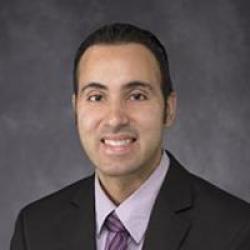Epidural injections didn't give much relief
"The doctor I was initially seeing tried epidural injections, but I wasn't really getting much pain relief," Kimberly said. "I was walking around on average with a pain level of five on a scale of one to 10. That was pretty intense."
When her doctor at a pain clinic suggested surgical intervention, Kimberly sought a second opinion. She met with Harvinder Deogun, MD, a physical medicine and rehabilitation physician and independent member of the HonorHealth Medical Staff. Dr. Deogun specializes in interventional spine and sports medicine with HonorHealth Spine Group Arizona.
"I switched to Dr. Deogun when it was time for a consultation," Kimberly shared. "After meeting with him, I realized he did a lot of the same stuff as the pain clinic I had been going to. We decided to continue exploring non-surgical treatments before jumping right to surgery."
Targeted injections, yoga, physical therapy and weight training
"Dr. Deogun started with injections, but he had different types of injections to specifically address my area of pain," she said. "It felt more targeted and more personalized. I'm young, and I wanted someone like Dr. Deogun to look at my case and take into consideration my age, family and work."
"By initially providing the least invasive options, patients feel more comfortable and in control of their healthcare," said Dr. Deogun. "That said, should conservative options not help, more invasive treatment strategies, such as spine surgery, are also available. This way, more aggressive treatment is sought only after the appropriate conservative options have been exhausted."
Dr. Deogun began with steroid injections in the sacroiliac or SI joint, which is located between the sacrum and the ilium bones in the pelvic area.
"These are more direct injections that go right to where I have chronic pain, and they're working," Kimberly shared. "My pain level is about a two now with just a dull ache. I notice a significant day-to-day decrease in pain after injections."
Along with injection therapy every three to four months, Kimberly's pain management regimen includes physical therapy, weight training and yoga to help strengthen her core and back muscles. However, surgery is likely in her future.
"I have arthritis and a tear in a disc," she said. "It's better right now, but it's easy to reinjure. The doctors and I know that I'll need surgery at some point, but we're putting it off as long as possible."
Kimberly continued, "I never really understood the debilitating effects of back injuries until I went through it myself. My quality of life is so much better now that I found the right doctor and started getting the right care."

